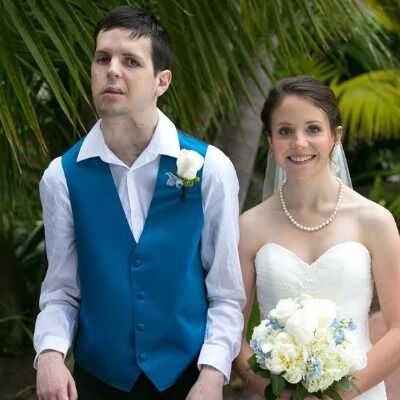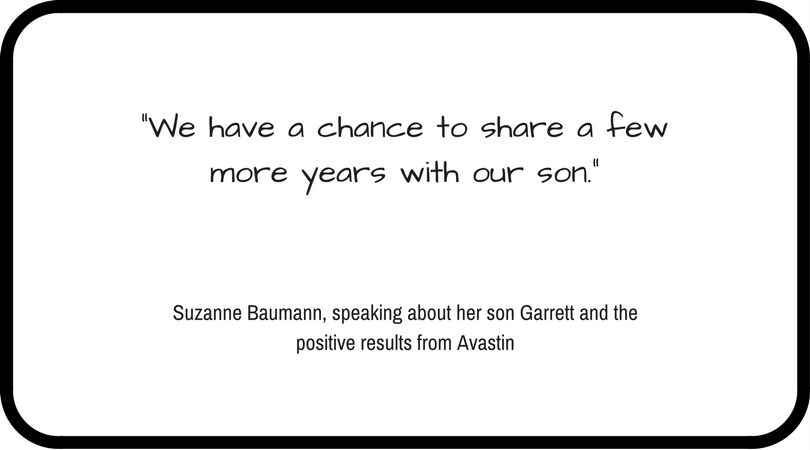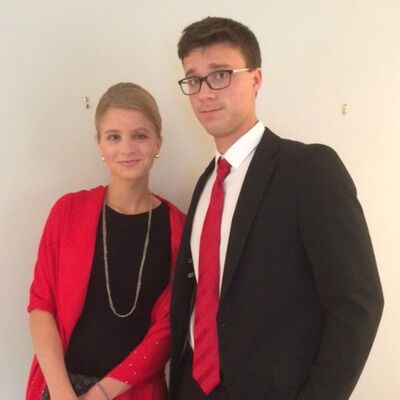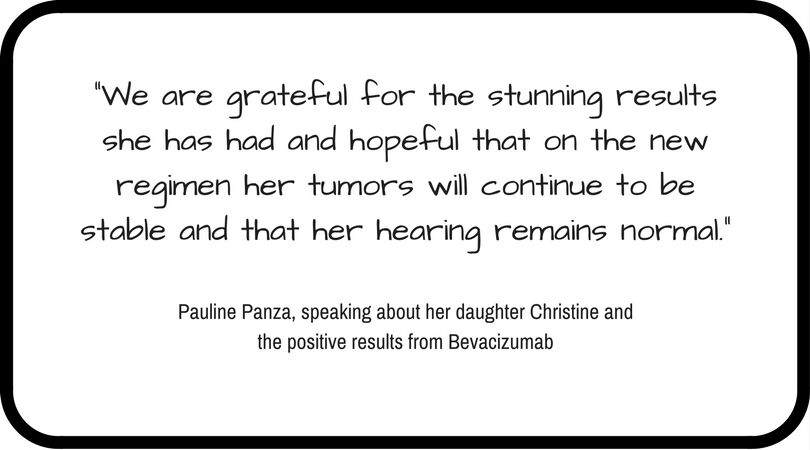Every year, on the last day of February, we recognize Rare Disease Day, a time for the entire rare disease community to come together to raise awareness. NF affects 1 in 3,000 people overall; NF2 is even more rare (1 in 25,000) and schwannomatosis even more rare (1 in 40,000). These days, there is a lot of excitement and hope for the MEK clinical trial for inoperable NF1 plexiform tumors (click here to read about the trial). Over 70% of patients had a dramatic response and saw their tumors shrink 20% or more. This is unprecedented and really makes us hope that this drug will soon be approved by the FDA as the first-ever treatment for NF1. But what about NF2? Even though it’s the MEK trial making headlines in NF these days, there is a lot going on also for NF2. In recognition of Rare Disease Day, we’re sharing these stories about two adults living with NF2 and their experiences in the Avastin (Bevacizumab) trial.
Garrett Baumann
(As told by his mother, Suzanne Baumann)
 When Garrett was a baby, we knew there was something wrong, but it took 11 years before the medical physicians diagnosed him correctly. At two years of age, Garrett had what was diagnosed as tumors or scar tissue on his retinas, but the physicians fought over who was correct and neither of them made the correct diagnosis. While other hallmarks were noticed in grade school, including café au lait marks and neurofibromas, the physicians still did not make the correct diagnosis. While in 5th grade, the school noticed his hearing loss, and we finally learned that Garrett had NF2. From that point on we were on a roller coaster trying to find out the what, where, when, and how of this disorder.
When Garrett was a baby, we knew there was something wrong, but it took 11 years before the medical physicians diagnosed him correctly. At two years of age, Garrett had what was diagnosed as tumors or scar tissue on his retinas, but the physicians fought over who was correct and neither of them made the correct diagnosis. While other hallmarks were noticed in grade school, including café au lait marks and neurofibromas, the physicians still did not make the correct diagnosis. While in 5th grade, the school noticed his hearing loss, and we finally learned that Garrett had NF2. From that point on we were on a roller coaster trying to find out the what, where, when, and how of this disorder.
Unfortunately, the medical community was completely contradictory on what to do next. Some experts said surgery was required; some said radiation was the only way; while others said “watch and wait.” We felt alone in the learning process of this disorder. We traveled all over the country to find knowledgeable staff. To this date, our home town, a large city (San Diego) has yet to start an NF clinic. We registered Garrett with the NF Registry and participated in the NIH NF study for three years. Unfortunately at the time, there were no new trials that were available to us. We prayed that a new drug would be found as Garrett’s condition worsened.
 Garrett has undergone three different radiation treatments to save him from hearing loss and facial paralysis. It gave him time to finish high school, but his tumors continued to grow and destroyed his hearing. Many more tumors grew within his body and many were removed to save bodily function. He had three brain surgeries, four spinal surgeries, and several surgeries to remove persistent neck tumors. One removal of a C2 tumor damaged the swallowing nerve, resulting in his inability to eat, leaving Garrett with a permanent feeding tube. Without the protection of proper throat function, Garrett was in constant danger of aspiration. He was in a cycle of nausea, aspiration, pneumonia and hospitalization. A total laryngectomy was performed to stop this cycle, but it cost him his voice. Now Garrett cannot hear, speak, eat, or see well. His 5′ 9″ frame was down to 88 pounds. His doctor told us to seek palliative care because there was nothing for him now. He told Garrett he was dying.
Garrett has undergone three different radiation treatments to save him from hearing loss and facial paralysis. It gave him time to finish high school, but his tumors continued to grow and destroyed his hearing. Many more tumors grew within his body and many were removed to save bodily function. He had three brain surgeries, four spinal surgeries, and several surgeries to remove persistent neck tumors. One removal of a C2 tumor damaged the swallowing nerve, resulting in his inability to eat, leaving Garrett with a permanent feeding tube. Without the protection of proper throat function, Garrett was in constant danger of aspiration. He was in a cycle of nausea, aspiration, pneumonia and hospitalization. A total laryngectomy was performed to stop this cycle, but it cost him his voice. Now Garrett cannot hear, speak, eat, or see well. His 5′ 9″ frame was down to 88 pounds. His doctor told us to seek palliative care because there was nothing for him now. He told Garrett he was dying.
As parents, were not going to give up. We fought to control his pain and weight. When he gained strength, he was given some trial chemo drugs, but the tumors continued to grow. He recently was switched to Avastin. Doctors told us this was our last hope. To our surprise, we recently learned that many of the tumors have shrunk, especially those in dangerous areas that threatened his life. We have a chance to share a few more years with our son. Hopefully, research and funding will continue, quickly, so that we can find a cure to this monstrous disorder called NF.
(Above, Garrett pictured with his sister on her wedding day.)
Christine Panza
(As told by her mother, Pauline Panza)
 In 2008, when Christine was in third grade she began to have unusual 30-second episodes during which she would begin to drool and gag uncontrollably. Sometimes she would run to the bathroom as if she were going to vomit. The first few times we ignored it because she would quickly return to her normal state and carry on with whatever task she had been engaged in as if nothing had happened. Eventually, we ran the scenario by her pediatrician and suggested that she might be having short seizures but the doctor insisted it was simple indigestion. After a year and several embarrassing episodes that occurred at her school, we demanded a referral to a neurologist just to rule out the possibility of seizures. The neurologist quickly saw that something was not right and ordered an MRI. A week later he called to tell me that my beautiful 9 year old daughter had several brain tumors.
In 2008, when Christine was in third grade she began to have unusual 30-second episodes during which she would begin to drool and gag uncontrollably. Sometimes she would run to the bathroom as if she were going to vomit. The first few times we ignored it because she would quickly return to her normal state and carry on with whatever task she had been engaged in as if nothing had happened. Eventually, we ran the scenario by her pediatrician and suggested that she might be having short seizures but the doctor insisted it was simple indigestion. After a year and several embarrassing episodes that occurred at her school, we demanded a referral to a neurologist just to rule out the possibility of seizures. The neurologist quickly saw that something was not right and ordered an MRI. A week later he called to tell me that my beautiful 9 year old daughter had several brain tumors.
We consulted with our pediatrician who referred us to Children’s Hospital of Philadelphia. We remained there under the care of Drs. Licht (Neurology) and Belasco (Oncology) for six years. During that time Christine had seven surgeries to remove/debulk peripheral tumors in her forearm and orbital area. Although the eye surgeries were ultimately successful, the surgery on her ulnar nerve could not be excised and as a result, she has only partial function and significant atrophy of her left hand and forearm. In 2013 she had tendon transfers and capsulodeses performed by Dr. Levin at Penn to stabilize her joints and improve function to her left hand.
Up to that point her major symptoms had been poor balance, seizures and the effects of the peripheral tumors. We had been monitoring her hearing and had avoided the dreaded hearing loss that is so often the hallmark of NF2, but in 2015 Christine’s word recognition dropped significantly in her left ear. At that time we began exploring options to address the effects of her growing vestibular schwannomas. We considered proton therapy, surgery and chemotherapy and concluded that the first two options could have permanent and irreversible damaging effects. It seemed that chemotherapy (with a biologic) was the most conservative approach, but we were concerned with whether our insurance would cover the treatment. We contacted Dr. Scott Plotkin at Massachusetts General Hospital but could not get an appointment with him for several months. At this time Christine’s hearing was diminishing rapidly and she was experiencing extreme tinnitus in both ears which was interfering with her school work and social life.
 In April of 2015 we attended the NF Conference in Arizona and had a fortuitous lunch with Dr. Plotkin poolside at the hotel. Upon learning of Christine’s situation he thought she would be a perfect candidate for a phase 2 bevacizumab trial for which he was the principal investigator. He immediately moved her appointment up and we agreed to join the trial beginning in August of 2015. Initially, Christine had wanted to receive treatment at MGH because of her confidence in Dr. Plotkin but ultimately it was not practical for us to travel 4 hours each way every two weeks. We returned to NYU to receive treatment with the new clinic coordinator.
In April of 2015 we attended the NF Conference in Arizona and had a fortuitous lunch with Dr. Plotkin poolside at the hotel. Upon learning of Christine’s situation he thought she would be a perfect candidate for a phase 2 bevacizumab trial for which he was the principal investigator. He immediately moved her appointment up and we agreed to join the trial beginning in August of 2015. Initially, Christine had wanted to receive treatment at MGH because of her confidence in Dr. Plotkin but ultimately it was not practical for us to travel 4 hours each way every two weeks. We returned to NYU to receive treatment with the new clinic coordinator.
After the first six infusions of bevacizumab, Christine’s vestibular tumors had decreased by 10% in volume, but more importantly, her word recognition had improved from 50% to 86%. After another six infusions, her word recognition further improved to 94%. She receives her infusions through an IV with no discomfort and she has tolerated the drug well with minimal side effects (nosebleeds, amenorrhea and headaches, but these have been manageable). We have just begun the maintenance phase of the trial during which she receives a decreased dose and frequency. We are grateful for the stunning results she has had and hopeful that on the new regimen her tumors will continue to be stable and that her hearing remains normal.
(Above, Christine pictured with her brother at a CTF Gala.)
Click here to read what Children’s Tumor Foundation VP, Research & Development Salvatore La Rosa, PhD, has to say about this trial, plus three others for NF2 patients.

